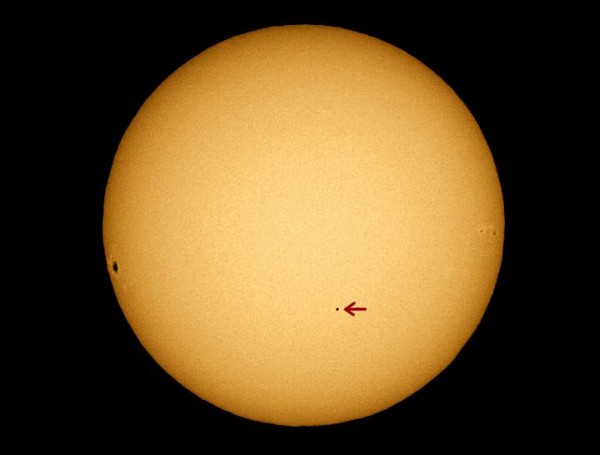Mercury Transits the Sun on May 9; View it Safely
| Arthur Dominic Villasanta | | May 03, 2016 10:02 AM EDT |
Transit of Mercury. Mercury appears as a small dot (arrow) during the transit of 2006.
A very rare Transit of Mercury will occur on May 9 and those fortunate enough to see it first-hand are warned it shouldn't be viewed using pinhole projectors. A safer way to view this astronomical event will be to project the image of the sun using either a filtered telescope or binoculars.
Like Us on Facebook
And remember to never look directly at the sun during the transit.
You can also watch this once-in-a-lifetime event online. Just check for websites with livestreams. The transit is also on Twitter at the hashtag #MercuryTransit2016 for those that want to share their excitement.
The transit will be visible in full or in part in most of the Earth. It will be visible from the eastern part of North America; most of Western Europe; the western part of North and West Africa and most of South America.
Most of the transit (either ending with sunset or starting at sunrise) will be visible from the rest of North and South America; the eastern half of the Pacific, the rest of Africa and most of Asia. Observers in eastern Asia, southeastern Asia and Australasia won't be able see the transit, however.
The transit begins 11:12:19 GMT in the United Kingdom or 7:12:19 a.m. EDT. The event will last 7-1/2 hours in the UK.
During the transit, Mercury will appear as a small dot in the lower half of the sun. It will be very different in appearance from the sunspot groups on the right and left hand limbs of the Sun.
A transit of Mercury takes place when the smallest planet in our solar system passes directly between the Earth and the Sun. It occurs only some 13 times every century.
The last time a transit of Mercury took place was in 2006. The next two will occur in 2019 and 2032. Mercury's transits currently take place in either early May or November.
TagsTransit of Mercury, Mercury, Earth, Sun
©2015 Chinatopix All rights reserved. Do not reproduce without permission
EDITOR'S PICKS
-

Did the Trump administration just announce plans for a trade war with ‘hostile’ China and Russia?
-

US Senate passes Taiwan travel bill slammed by China
-

As Yan Sihong’s family grieves, here are other Chinese students who went missing abroad. Some have never been found
-

Beijing blasts Western critics who ‘smear China’ with the term sharp power
-

China Envoy Seeks to Defuse Tensions With U.S. as a Trade War Brews
-

Singapore's Deputy PM Provides Bitcoin Vote of Confidence Amid China's Blanket Bans
-

China warns investors over risks in overseas virtual currency trading
-

Chinese government most trustworthy: survey
-

Kashima Antlers On Course For Back-To-Back Titles
MOST POPULAR
LATEST NEWS
Zhou Yongkang: China's Former Security Chief Sentenced to Life in Prison

China's former Chief of the Ministry of Public Security, Zhou Yongkang, has been given a life sentence after he was found guilty of abusing his office, bribery and deliberately ... Full Article
TRENDING STORY

China Pork Prices Expected to Stabilize As The Supplies Recover

Elephone P9000 Smartphone is now on Sale on Amazon India

There's a Big Chance Cliffhangers Won't Still Be Resolved When Grey's Anatomy Season 13 Returns

Supreme Court Ruled on Samsung vs Apple Dispute for Patent Infringement

Microsoft Surface Pro 5 Rumors and Release Date: What is the Latest?














